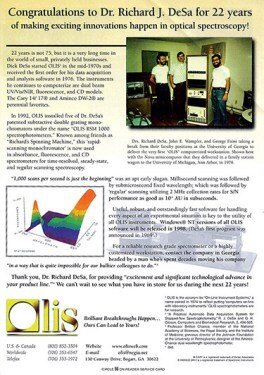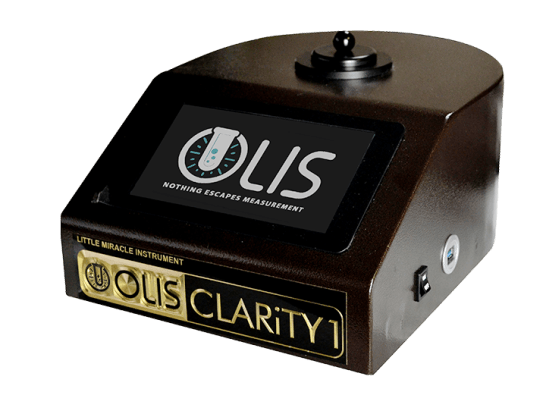The Single Strategy To Use For Uv/vis/nir
The Single Strategy To Use For Uv/vis/nir
Blog Article
The 9-Second Trick For Circularly Polarized Luminescence
Table of ContentsSome Known Incorrect Statements About Uv/vis/nir The 3-Minute Rule for Circular DichroismThe Definitive Guide for Uv/vis/nirUv/vis Things To Know Before You Get ThisFascination About Circularly Polarized LuminescenceCircularly Polarized Luminescence for Dummies4 Easy Facts About Circularly Polarized Luminescence ExplainedUv/vis/nir - TruthsRumored Buzz on Circularly Polarized Luminescence7 Simple Techniques For Uv/visThe 8-Minute Rule for Uv/visMore About Uv/visThe smart Trick of Spectrophotometers That Nobody is Discussing
It is then scanned through the sample and the reference solutions. Fractions of the occurrence wavelengths are transferred through, or reflected from, the sample and the reference. The resultant light strikes the photodetector gadget, which compares the relative strength of the two beams. Electronic circuits transform the relative currents into direct transmission percentages and/or absorbance/concentration worths.The transmission of a recommendation substance is set as a standard (information) value, so the transmission of all other compounds are tape-recorded relative to the preliminary "zeroed" substance. The spectrophotometer then transforms the transmission ratio into 'absorbency', the concentration of particular elements of the test sample relative to the preliminary substance.
Given that samples in these applications are not readily offered in large quantities, they are especially fit to being evaluated in this non-destructive strategy. In addition, precious sample can be conserved by utilizing a micro-volume platform where as low as 1u, L of sample is needed for complete analyses. A short description of the treatment of spectrophotometry includes comparing the absorbency of a blank sample that does not consist of a colored compound to a sample which contains a colored substance.
Indicators on Circular Dichroism You Should Know
In biochemical experiments, a chemical and/or physical residential or commercial property is chosen and the procedure that is utilized specifies to that residential or commercial property in order to obtain more information about the sample, such as the amount, pureness, enzyme activity, etc. Spectrophotometry can be used for a variety of techniques such as figuring out optimal wavelength absorbance of samples, figuring out optimal p, H for absorbance of samples, figuring out concentrations of unknown samples, and determining the p, Ka of different samples.: 21119 Spectrophotometry is likewise a valuable procedure for protein filtration and can also be used as an approach to create optical assays of a compound.
It is possible to know the concentrations of a 2 component mixture utilizing the absorption spectra of the standard solutions of each component. To do this, it is required to understand the termination coefficient of this mix at 2 wave lengths and the termination coefficients of solutions that include the recognized weights of the two elements.

6 Simple Techniques For Circularly Polarized Luminescence
The majority of spectrophotometers are used in the UV and visible areas of the spectrum, and a few of these instruments also operate into the near-infrared Area. The concentration of a protein can be approximated by determining the OD at 280 nm due to the presence of tryptophan, tyrosine and phenylalanine (https://www.wattpad.com/user/olisclarity1).
This method needs a spectrophotometer capable of measuring in the UV area with quartz cuvettes.: 135 Ultraviolet-visible (UV-vis) spectroscopy includes energy levels that thrill electronic shifts. Absorption of UV-vis light excites molecules that are in ground-states to their excited-states.
20. 8 O.D. Ink makers, printing business, textiles suppliers, and many more, require the information supplied through colorimetry. They take readings in the region of every 520 nanometers along the visible area, and produce a spectral reflectance curve or an information stream for alternative discussions. These curves can be used to check a brand-new batch of colorant to check if it makes a match to specifications, e.
Spectrophotometers Can Be Fun For Anyone
Standard noticeable region spectrophotometers can not discover if a colorant or the base material has fluorescence. This can make it challenging to manage color problems if for instance one or more of the printing inks is fluorescent. Where a colorant contains fluorescence, a bi-spectral fluorescent spectrophotometer is utilized (http://connect.releasewire.com/company/olis-clarity-343997.htm). There are 2 significant setups for visual spectrum spectrophotometers, d/8 (round) and 0/45.
Scientists use this instrument to determine the quantity of compounds in a sample. If the substance is more concentrated more light will be absorbed by the sample; within small ranges, the Beer, Lambert law holds and the absorbance between samples vary with concentration linearly. In the case of printing measurements two alternative settings are typically utilized- without/with uv filter to manage much better the effect of uv brighteners within the paper stock.
Circular Dichroism Fundamentals Explained
Some applications need little volume measurements which can be carried out with micro-volume platforms. As explained in the applications section, spectrophotometry can be utilized in both qualitative and quantitative analysis of DNA, RNA, and proteins. Qualitative analysis can be utilized and spectrophotometers are used to tape spectra of substances by scanning broad wavelength regions to figure out the absorbance properties (the intensity of the color) of the compound at each wavelength.

The Buzz on Circularly Polarized Luminescence
One significant element is the kind of photosensors that are readily available for various spectral areas, however infrared measurement is likewise tough because practically everything discharges IR as thermal radiation, especially at wavelengths beyond about 5 m. Another problem is that numerous products such as glass and plastic soak up infrared, making it incompatible as an optical medium.
Samples for IR spectrophotometry might be smeared in between 2 discs of potassium bromide or ground with potassium bromide and pushed into a pellet. Where liquid options are to be determined, insoluble silver chloride is utilized to build the cell. Spectroradiometers, which run practically like the noticeable region spectrophotometers, are developed to determine the spectral density of illuminants. Retrieved Dec 23, 2018. Fundamental Laboratory Techniques for Biochemistry and Biotechnology (2nd ed.). The essential guide to analytical chemistry.
Chichester, NY: Wiley. pp. 1617. ISBN 9780471974123. OCLC 36543293. Ninfa AJ, Ballou DP (2004 ). Basic lab techniques for biochemistry and biotechnology. Hoboken: Wiley. p. 66. ISBN 9781891786006. OCLC 633862582. Rendina G (1976 ). Philadelphia, PA: W. B. Saunders Business. pp. 46-55. ISBN 0721675506. OCLC 147990. Oke, J. B.; Gunn, J. E.
Our Spectrophotometers Ideas
"Secondary standard stars for absolute spectrophotometry". The Astrophysical Journal. 266: 713. Bibcode:1983 Ap, J..266..713 O. doi:10. 1086/160817. Ishani, G (2006 look at this website ). "The first commercial UV-vis spectrophotometer". p. 100. Retrieved Dec 23, 2018. Simoni, RD; Hill, RL; Vaughan, M; Tabor, H (Dec 5, 2003). "A Traditional Instrument: The Beckman DU Spectrophotometer and Its Innovator, Arnold O.
278 (49 ): e1. doi:. ISSN 1083-351X. Beckman, A. O.; Gallaway, W. S.; Kaye, W.; Ulrich, W. F. (March 1977). "History of spectrophotometry at Beckman Instruments, Inc". Analytical Chemistry. 49 (3 ): 280A300A. doi:10. 1021/ac50011a001. "Hewlett Packard: Substance Recognition with HP 8450 A UV Visible Spectrophotometer". Analytical Chemistry. 51 (12 ): 1188A1189A. 1979-10-01.
Ninfa AJ, Ballou DP, Benore M (2015 ). Essential Laboratory Methods for Biochemistry and Biotechnology (3, rev. ed.). UV/Vis. Lab Equipment.
Excitement About Uv/vis/nir
"Applied Spectrophotometry: Analysis of a Biochemical Mixture". Biochemistry and Molecular Biology Education. Journal of Biochemistry Education.
The Only Guide to Spectrophotometers
U.S. Department of Commerce National Bureau of Standards special publication; 378. Washington, D.C.: U.S. National Bureau of Standards.
The process starts with a controlled light source that lights up the evaluated sample. When it comes to reflection, as this light engages with the sample, some is soaked up or given off. The produced light travels to the detector, which is evaluated, measured, and presented as industry-standard color scales and indices.
Market governing bodies normally define particular metrics for particular products, such as Tomato and Coffee indices. The streamlined math appears like this: Where R is the reflection coefficient. All terms are examined over the visible spectrum from 400 to 700 nm. In the case of transmission, when the light communicates with the sample, it is either absorbed, shown, or transmitted.
What Does Circular Dichroism Do?
Examples consist of APHA (American Public Health Association) for watercolor and pureness analysis, ASTM D1500 for petrochemical color analysis, edible oil indices utilized in food, and color analyses of drinks. All terms are examined over the noticeable spectrum from 400 to 700 nm.
Image Credit: Matej Kastelic/ Dr. Arnold J. Beckman and his colleagues at the National Technologies Laboratories initially created the spectrophotometer in 1940. In 1935 Beckman established the company, and the discovery of the spectrophotometer was their most ground-breaking innovation.
Some Known Details About Circularly Polarized Luminescence
99% precision. In time, researchers kept enhancing the spectrophotometer design to boost its efficiency. The UV abilities of the model B spectrophotometer were enhanced by changing the glass prism with a quartz prism. Eventually, the Model DU was produced, including a hydrogen light and other enhancements. This instrument was used in industrial labs, centers, and chemistry and biochemistry departments.
Normally, a spectrophotometer is made up of 2 instruments, specifically, a spectrometer and a photometer. A fundamental spectrophotometer contains a light source, a monochromator, a collimator for straight light beam transmission, a cuvette to position a sample, and a photoelectric detector.
The Best Guide To Circularly Polarized Luminescence
There are different types of spectrophotometers in numerous sizes and shapes, each with its own purpose or functionality. A spectrophotometer identifies how much light is shown by chemical parts. circular dichroism. It measures the distinction in light intensity based upon the overall amount of light presented to a sample and the amount of beam that travels through the sample option
According to the instrument's style, the sample is placed in between the spectrometer and the photometer. After the light is passed through the sample, the photometer determines its intensity and displays the reading. A spectrophotometer is utilized to figure out the concentration of both colorless and colored solutes in a service. This instrument is utilized to figure out the rate of a reaction.
Report this page